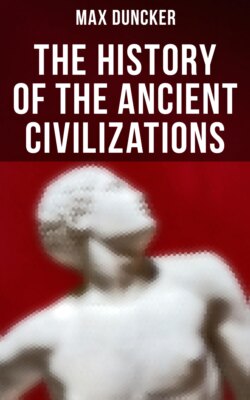Читать книгу The History of the Ancient Civilizations - Duncker Max - Страница 50
На сайте Литреса книга снята с продажи.
FOOTNOTES:
Оглавление[1] Strabo, pp. 736, 737. Arrian, "Anab." 3, 7, 7. The same form of the name, Athura, is given in the inscriptions of Darius.
[2] Plin. "Hist. Nat." 6, 27; 5, 12: Adiabene Assyria ante dicta. Ptolemæus (6, 1) puts Adiabene and Arbelitis side by side. Diodorus, 18, 39. Arrian, Epit. 35: τὴν μὲν μἑσην τῶν ποταμῶν γῆν καὶ τὴν Ἀρβηλῖτιν ἔνειμε Ἀμφιμάχῳ.
[3] Polyb. 5, 54. The border line between the original country of Assyria and Elam cannot be ascertained with certainty. According to Herodotus (5, 52) Susa lay 42 parasangs, i.e. about 150 miles, to the south of the northern border of Susiana. Hence we may perhaps take the Diala as the border between the later Assyria and Elam. The use of the name Assyria for Mesopotamia and Babylonia, as well as Assyria proper, in Herodotus (e.g. 1, 178) and other Greeks—the name Syria, which is only an abbreviation of Assyria (Herod. 7, 63)—arises from the period of the supremacy of Assyria in the epoch 750–650 B.C. Cf. Strabo, pp. 736, 737, and Nöldeke, ΑΣΣΥΡΙΟΣ, Hermes, 1871 (5), 443 ff.
[4] The Euphrates, which Diodorus mentions 2, 3 and also 2, 27, is not to be put down to a mistake of Ctesias, since Nicolaus (Frag. 9, ed. Müller) describes Nineveh as situated on the Tigris in a passage undoubtedly borrowed from Ctesias. The error belongs, as Carl Jacoby ("Rhein. Museum," 30, 575 ff.) has proved, to the historians of the time of Alexander and the earliest Diadochi, who had in their thoughts the city of Mabog (Hierapolis), on the Euphrates, which was also called Nineveh. The mistake has passed from Clitarchus to the narrative of Diodorus.
[5] Steph. Byzant. Χαύων, χώρα τῆς Μηδίας, Κτησίας ἐν πρώτῳ Περτικῶν. Η δὲ Σεμιραμις ἐντεῦθεν ἐξελαύνει, κ. τ. λ.
[6] Diod. 1, 56.
[7] Frag. 7, ed. Müller.
[8] Frag. 1, 2, ed. Müller; cf. Justin. 1, 1.
[9] Anonym. tract. "De Mulier." c. 1.
[10] Diod. 2, 21.
[11] Nicol. Frag. 8, ed. Müller.
[12] 1, 184.
[13] Strabo, pp. 80, 529, 737; Lucian, "de Syria dea," c. 14.
[14] Herod. 1, 102.
[15] Xenoph. "Anab." 3, 4, 6–10.
[16] Diodorus tells us himself (2, 7) that in writing the first 30 chapters of his second book he had before him the book of Clitarchus on Alexander. Carl Jacoby (loc. cit.)—by a comparison with the statements in point in Curtius, who transcribed Clitarchus, and by the proof that certain passages in the narrative of Diodorus which relate to Bactria and India are in agreement with passages in the seventeenth book, in which Diodorus undoubtedly follows Clitarchus; that certain observations in the description of Babylon in Diodorus can only belong to Alexander and his nearest successors; that certain preparations of Semiramis for the Indian campaign agree with certain preparations of Alexander for his Indian campaign, and certain incidents in Alexander's battle against Porus with certain incidents in the battle of Semiramis against Stabrobates; and finally by showing that the situation of the ancient Nineveh was unknown to the historians of the time of Alexander, who were on the other hand acquainted with a Nineveh on the Euphrates (Hierapolis, Mabog; Plin. "Hist. Nat." 5, 23; Ammian. Marcell. 14, 8, 7)—has made it at least very probable that Diodorus had Ctesias before him in the revision of Clitarchus. We may allow that Clitarchus brought the Bactrian Oxyartes into the narrative, unless we ought to read Exaortes in Diodorus; but that the name of the king in Ctesias was Zoroaster is in my opinion very doubtful. The sources of Ctesias were stories related by Persians or Medes from the epic of West Iran. That this should put Zoroaster at the time of Ninus, and make him king of the Bactrians, in order to allow him to be overthrown by the Assyrians, is very improbable. Whether Ctesias ascribed to Semiramis the building of Egbatana is also very doubtful; that he mentioned her stay in Media, and ascribed to her the building of the road over the Zagrus and the planting of gardens, follows from the quotation of Stephanus given above. Ctesias has not ascribed to her the hanging gardens at Babylon. Diodorus makes them the work of a later Syrian king, whom Ctesias would certainly have called king of Assyria. Ctesias too can hardly have ascribed to her the obelisk at Babylon (Diod. 2, 11); so at least the addition of Diodorus, "that it belonged to the seven wonders," seems to me to prove.
[17] "Catasterism." c. 38; Hygin. "Astronom." 2, 41. In Diodorus Aphrodite, enraged by a maiden, Derceto, imbues her with a fierce passion for a youth. In shame she slays the youth, exposes the child, throws herself into the lake of Ascalon, and is changed into a fish. For this reason the image of the goddess Derceto at Ascalon has the face of a woman and the body of a fish (2, 4).
[18] Diod. 2, 17, init.
[19] Georg. Syncell. p. 119, ed. Bonn.
[20] Diod. 1, 56.
[21] "De Iside," c. 24.
[22] Diod. 2, 4, init.
[23] Herod. 1, 7.
[24] Lucian, "De Syria dea," c. 33, 14, 38. The name Semiramoth is found 1 Chronicles xv. 18, 20; xvi. 5; 2, xvii. 8.
[25] Ctesias in Strabo, p. 785.
[26] Agathias, 2, 24.
